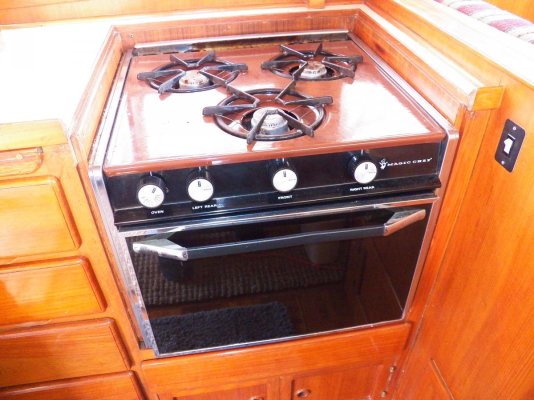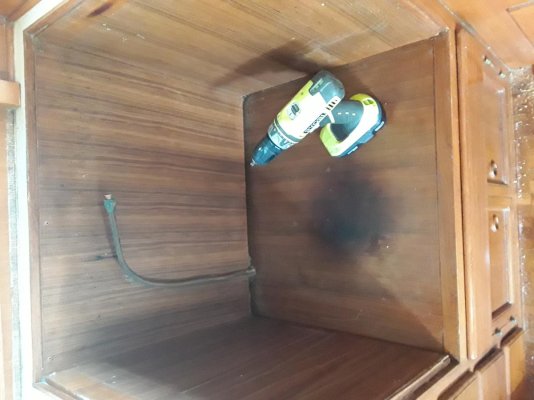Marco Flamingo
Guru
- Joined
- Jan 7, 2020
- Messages
- 1,189
- Location
- United States
- Vessel Name
- CHiTON
- Vessel Make
- Tung Hwa Clipper 30
I started removing some of the propane cooking appliances right after purchasing. There was a stainless BBQ hanging on a flying bridge stantion. It had a hose (removable) that threaded down to the propane tank on the back deck. My wife bought a BBQ at the house. It hasn't been out of a storage shed in 4 years. I don't see myself running up the the flying bridge to fetch the charred weenies. So I sold it. $100 in the black right from the start.
Our galley is a typical Tiawan trawler from the 80's. Teak cabinets, laminate counter top, propane stove that has a cover so that it is possible to have more counter space when the stove isn't in use. Magic Chef 3 burner without thermocouples on the burners. Surveyor said it needed them but then didn't put it down in the survey and the insurance company didn't see that. Thermocouples would have been over $100 and I would need to do some fabrication work.
It had the regular features on a propane stove. Drip rings to catch overboiled stuff and then cook on to the surface. I knew that induction cook tops don't need that. It had years of crap that had dropped down below the cook top. Induction doesn't have that. I decided I'd rather fabricate a new counter top to fit an induction stove.
I removed the stove and found a layer of dust bunnies in the 4 inch air gap below the oven. When cleaning out that area I noticed something else. You know that smoky aroma you get from using a propane stove on a boat? It isn't mesquite, it's teak. Removing the Magic Chef left a storage area that actually doubles the usable space in my galley. I just have to figure out how to use all the space.
Our galley is a typical Tiawan trawler from the 80's. Teak cabinets, laminate counter top, propane stove that has a cover so that it is possible to have more counter space when the stove isn't in use. Magic Chef 3 burner without thermocouples on the burners. Surveyor said it needed them but then didn't put it down in the survey and the insurance company didn't see that. Thermocouples would have been over $100 and I would need to do some fabrication work.
It had the regular features on a propane stove. Drip rings to catch overboiled stuff and then cook on to the surface. I knew that induction cook tops don't need that. It had years of crap that had dropped down below the cook top. Induction doesn't have that. I decided I'd rather fabricate a new counter top to fit an induction stove.
I removed the stove and found a layer of dust bunnies in the 4 inch air gap below the oven. When cleaning out that area I noticed something else. You know that smoky aroma you get from using a propane stove on a boat? It isn't mesquite, it's teak. Removing the Magic Chef left a storage area that actually doubles the usable space in my galley. I just have to figure out how to use all the space.





